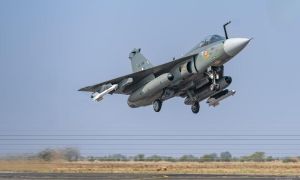
The U.S. Department of Defense (DoD) concluded its Virtual Flag: Coalition (VFC) 2024 exercise at Kirtland Air Force Base, marking another milestone in enhancing military collaboration between the U.S. and allied forces. Held from October 21 to November 4, the exercise drew over 400 military personnel from various branches of the U.S. military and allied forces, including the Royal Australian Air Force (RAAF), Canadian Armed Forces, and the UK Armed Forces.
Virtual Flag, an annual cornerstone of U.S. military training, utilizes a sophisticated virtual environment to simulate large-scale combat scenarios. This year, the exercise spotlighted modern warfare challenges in the Indo-Pacific region, a geopolitical flashpoint due to China’s increasing military assertiveness in areas such as the South China Sea and Taiwan.
“This exercise is key!” said RCAF Maj. Gary Stone, head of the Canadian delegation. “It’s all about coalition partnerships—partners and allies. We are a proud part of that warfighting integration team. This exercise is a testament to that idea.”
The Royal Australian Air Force echoed these sentiments, highlighting the importance of interoperability and preparedness. The training emphasized working closely with coalition partners to address complex and dynamic threats.
According to a U.S. Air Force press release, Virtual Flag: Coalition continues to expand, solidifying its position as one of the DoD’s largest theater-level joint combat exercises. Conducted in a live, virtual, and constructive environment, the exercise enables participants to simulate offensive and defensive combat scenarios against peer adversaries.
The exercise, led by the 705th Combat Training Squadron’s Distributed Mission Operations Center (DMOC) at Kirtland, employed a nine-day cycle of rigorous training. The DMOC seamlessly integrated simulators from its headquarters and other global sites, creating an immersive and cohesive virtual training environment.
- E-3 Airborne Warning and Control System (AWACS)
- E-8 Joint Surveillance Target Attack Radar System (JSTARS)
- Remotely Piloted Aircraft (RPA) systems
- Joint Terminal Attack Controller (JTAC) systems
- Distributed Common Ground System (DCGS)
This setup allowed thousands of warfighters to engage in realistic combat simulations annually.
Virtual Flag encompasses a multi-domain approach, integrating air, land, sea, space, and cyber operations. This year’s exercise emphasized the Indo-Pacific theater, reflecting growing tensions and the evolving nature of modern warfare.
- Emerging Threats: Simulations prepared forces to respond to actions from China, North Korea, and Russia, aligning with the Department of Defense’s latest National Defense Strategy.
- Expanded Area of Responsibility (AOR): The exercise covered a geographically expansive Indo-Pacific region, addressing challenges like the “tyranny of distance” and the need for seamless logistics and communication.
- Maritime Integration: A larger emphasis on naval operations ensured that coalition forces could collaborate effectively in sea-based scenarios.
The ability to operate cohesively with international partners is central to the exercise’s mission. U.S. Air Force Lt. Col. David Jones, commander of the DMOC, stressed the importance of this interoperability.
“Our DoD policy is clear,” he said. “If we were to go to war, we are not going alone. We are going to go with our allies and partners, and we have got to make sure that we can communicate through the right systems, have the same operational mindset, and use the same tactical vernacular.”
This collaborative ethos ensures that coalition forces can respond rapidly and decisively to threats, overcoming operational and cultural barriers to work as a unified team.
The Indo-Pacific has become the epicenter of global strategic competition, with China’s growing military footprint raising alarms among the U.S. and its allies. Beijing’s provocative actions in the South China Sea, frequent incursions near Taiwan, and the expansion of its military capabilities have underscored the need for readiness.
Virtual Flag: Coalition serves as a vital tool in adapting to this shifting landscape. Last year’s exercise saw a major strategic adjustment, aligning the event’s objectives with the DoD’s Indo-Pacific strategy and broadening the geographic scope to reflect the region’s importance.
The expanded AOR in the Indo-Pacific presented unique logistical and operational challenges for participating forces. The vast distances involved required innovative solutions for supply chain management, communication, and coordination.
Additionally, the integration of multiple domains—land, air, space, cyber, and maritime—added layers of complexity
- Cyber Operations: Participants defended critical systems from simulated cyberattacks, reflecting real-world threats.
- Space Domain: Coalition forces trained to counter potential adversarial actions in space, such as satellite interference or anti-satellite weaponry.
- Maritime Security: Scenarios tested readiness in securing shipping lanes and responding to naval threats.
The exercise underscored the growing alignment among the U.S. and its allies to confront shared security challenges. Increased cooperation is particularly critical as China seeks to expand its influence in the Indo-Pacific, often clashing with the interests of the U.S. and its partners.
By fostering a shared understanding of tactics, strategies, and operational goals, Virtual Flag helps ensure that coalition forces can present a united front in times of crisis.
As geopolitical tensions remain high, exercises like Virtual Flag are expected to grow in scope and sophistication. The DoD has already announced plans to further integrate emerging technologies such as artificial intelligence (AI) and autonomous systems into future training scenarios.
The success of this year’s Virtual Flag: Coalition demonstrates the value of these efforts, solidifying the importance of virtual training in preparing for real-world challenges.
With the Indo-Pacific region at the center of global security concerns, the collaboration fostered during VFC 2024 represents a crucial step in strengthening alliances and maintaining peace through deterrence and readiness.






